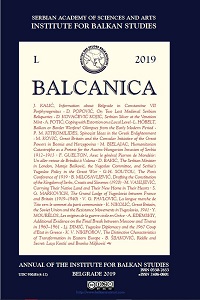The Grand Lodge of Yugoslavia between France and Britain (1919–1940)
The Grand Lodge of Yugoslavia between France and Britain (1919–1940)
Author(s): Slobodan G. MarkovićSubject(s): History, Social Sciences
Published by: Balkanološki institut - Srpska akademija nauka i umetnosti
Keywords: Grand Lodge of Yugoslavia;French Freemasonry;United Grand Lodge of England;Duke of York;Douchan Militchevitch;Stanoje Mihajlović;Vladimir Ćorović;
Summary/Abstract: The paper deals with the orientation of the Yugoslav freemasonry during the existence of the Grand Lodge of Serbs, Croats and Slovenes “Jugoslavia” (GLJ), later the Grand Lodge of Yugoslavia (GLY). The state of freemasonry in Serbia on the eve of the Great War is briefly described and followed by an analysis of how the experience of the First World War influenced Serbian freemasons to establish strong ties with French freemasonry. During the 1920s the Grand Lodge “Jugoslavia” maintained very close relations with the Grand Orient of France and the Grand Lodge of France, and this was particularly obvious when GLJ got the opportunity to organise the Masonic congress for peace in Belgrade in 1926 through its links with French Freemasonry. Grand Master Georges Weifert (1919–34) also symbolised close links of French and Serbian freemasonry. However, his deputy and later Grand Master Douchan Militchevitch (1934–39) initiated in 1936 the policy of reorientation of Yugoslav freemasonry to the United Grand Lodge of England. Although there had already been such initiatives, they could not be materialised due to the fact that it was not until 1930 that the United Grand Lodge of England (UGLE) recognised several continental grand lodges, including GLJ. In a special section efforts of GLJ to be recognised by UGLE are analysed. Efforts for reorientation of GLY were conducted through several persons, including Douchan Militchevitch (1869–1939), Stanoje Mihajlović (1882–1946), Vladimir Ćorović (1885–1941) and Dragan Militchevitch (1895–1942). Special attention is given to the plans of GLY’s grand master to make the Duke of York (subsequently King George VI), who was a very dedicated freemason, an honorary past master of GLY. This plan failed, and the main idea behind it was to make GLY more resistant to internal clerical attacks and also to the external pressure of Italy. Mihajlović’s three official Masonic visits to Britain (1933–39) are analysed as well as a private visit of Ćorović and Dragan Militchevitch in March 1940. In the context of the visits made in 1939–40 plans to establish an Anglo-Yugoslav lodge are also analysed. Finally, the context of the de facto ban on Yugoslav freemasonry in August 1940 is given and the subsequent fates of its pro-British actors are also described.
Journal: BALCANICA
- Issue Year: 2019
- Issue No: 50
- Page Range: 261-298
- Page Count: 38
- Language: English

